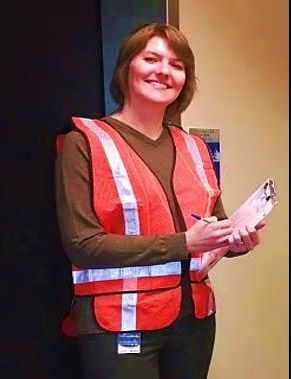Floor Captains Add Layer of Safety to Research Emergency Procedures
If there were a fire in your work area, would you know what to do or where to go?
Seven years ago, the Cincinnati Children’s Research Foundation (CCRF) formed an all-volunteer program to help protect the occupants of the research complex: Locations R and S, and later Location T. Until that time, fire drills comprised only the sounding of alarms, but no one left the buildings.
The Floor Captains Program was spearheaded by Kris Justus, PhD, vice president of the Research Foundation, and patterned after a program she implemented while in California. She led the implementation of the Floor Captains Program here, with a team that included Tammy Rausch, a laboratory safety consultant in the Office of Research Compliance and Regulatory Affairs (ORCRA), Colleen McGuire, a supervisor from Protective Services, and others.
The initial bolus of minor equipment for the program was funded by a grant from the Assistant Secretary of Preparedness and Response, through the Ohio Department of Health. The program held its first fire evacuation drill in 2014 with fewer than 100 volunteer floor captains. Since then, the Floor Captains Program has grown, according to Laura Runck, CCRF project manager, who began overseeing the effort in January 2019.
“We have about 124 captains—all volunteers—throughout Locations R, S and T and the old Research Building (ORB),” she said. “It’s a lot to keep up with, but it’s super important.”
In Locations R and T, there are four to five captains per floor; in Location S, there are two or three per floor in each wing—all spaced apart for the best coverage.
Each floor captain is charged with making sure people in their area are aware of the alarm, know how to safely exit the building during an emergency, and find their way to a specified rally point outside where they formally check in.
“The role of a floor captain is to direct people—including any visitors, vendors, or non-research employees who may be in the
building—to their evacuation route,” said Runck. “Once at the rally point, the floor captains have people sign in to record that they successfully made it out of the building. In a real-world situation, this information is key to ensuring everyone’s safety.”
If anyone has mobility challenges and can’t easily go down the stairs, floor captains direct them to remain in the stairwell (a fire-safe area) once others have exited. In this case, floor captains are also responsible for alerting Protective Services to the location where someone is sheltering so that the firefighters are aware and can assist them.
In terms of fire safety, Location T is considered one building, as is the ORB. Locations R and S are considered one building because there are no fire-rated doors between them.
“Sometimes during a drill, we’ve had a few people in Location S move to the atrium of Location T rather than walk down 10 flights of stairs,” said Runck. “That is not an evacuation—it’s actually posing a risk because it breaks through the fire barrier by opening the protective doors. This is another reason why the floor captains are so important—to help educate people on proper procedures and make sure they’re being compliant.”
In the event of a real fire, three floors are evacuated—the floor where the fire is happening, the floor above and the floor below. According to fire code, these are the floors that are initially most at risk.
Limiting evacuation also reduces congestion in the stairwells. With only three floors evacuating, it can take 15 minutes to get from the top floor of Location S down to the street level.
“If we evacuated every floor of a high-rise building at the same time, it would be chaos,” said Runck. “The ORB, because of its size, is the only exception where we evacuate the entire building at once.”
"Our floor captains are great -- they want to keep everyone safe. When I asked if they were willing to expand the focus beyond fire safety and take on additional training, they said, 'Yes, let's do it!'"
-- Laura Runck, project manager

Making Improvements
Since Runck has been managing the Floor Captains Program, she has worked with Amber Antoni, RN, director, Emergency Management, and Nathan Timm, MD, medical director, Emergency Management, to broaden the focus from fire safety to severe weather threats and active assailants. She has added training during quarterly meetings. Jim Whitaker, senior director of Protective Services, gave a presentation on active assailants last year. The floor captains were scheduled for Stop the Bleed training at the April meeting, but COVID-19 interfered. It’s been postponed until Spring 2021, to be followed by CPR training.
The team is also working on updating the yellow Emergency Preparedness binders to make them more specific to each area.
“Traditionally, the information in the binders has been generic,” said Runck. “But if I’m located on S10, it may not apply to me the way it would to someone on A5 or at Liberty Campus. So our floor captains are tailoring the instructions for each research site to make them more useful.
“We’re also hoping to standardize the location of the binders—putting them near the elevators or stairwells—so that even if you’re in an unfamiliar building, you would still know where to find it.”
The Floor Captains Program has successfully addressed the needs of the research community at Cincinnati Children’s, which are different from staff needs in the clinical environment. The team aims to spread the word about the program through development of an orientation for new Research Foundation employees.
Meanwhile, Runck will be transitioning her role as floor captain manager to Gina Hiles, operations coordinator, who is new to the Research Foundation and the medical center.
To find out more about the Floor Captain Program, go to http://centerlink.cchmc.org/research/research---tabs/fire-safety/floor-captains. Anyone interested in becoming a floor captain should contact Laura Runck at Laura.Runck@cchmc.org or uS-FloorCaptain@cchmc.org.
